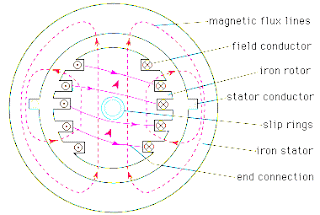The three-phase synchronous motor normally comes in high kW and voltage ratings. These motors are used for heavy load driving such as exercise fans, compressors, etc. These motors are designed to run continuously for months at a time.
In large industries, these motors serve the two-purpose of driving mechanical loads as well as power factor improvements. These motors can run at the leading electrical factor with an increase in excitation power. The main feature of a synchronous motor is its constant speed operation. The motor operates at a constant synchronous speed given by the supply frequency and multiple poles in the stator winding.
Construction
 |
| Synchronous Motors |
The motor mainly consists of cooling systems for the stator, rotor, bearing, and high kW motors.
Stator: - The stator is made of silicon steel lamination of the desired diameter and stacked to a suitable stator length. The motor kW rating depends on the air gap and core length on the diameter of the core. Radial ventilation ducts are provided at a regular distance of 70 to 80 mm for forced air cooling of the motor. The stator is wound with a three-phase winding with a suitable number of poles, depending on the speed of the motor. High voltage winding is used for motors above 500 kW rating. The voltage is usually 6.6 kv or 11 kv depending on the parameters of the supply system. The stator is fixed in the motor body. The body is made of steel with box-type fabricated construction.
 |
| Motors Construction |
Rotor: - Two types of rotors are used in synchronous motors.
1 Smooth Cylindrical Rotor - It is used in India for machines with 3000 RPM for 50 Hz. The smooth cylindrical rotor has slots on the periphery that distribute the winding to produce a sinusoidal magnetic field.
2 main polar rotor - It is used in motors with 1500 RPM and low RPM.
Main pole rotor- The number of poles in the rotor depends on the number of poles in the stator winding. For example, if a motor in the stator winding has 4 poles, the rotor will also have 4 poles and the 4 poles must be wound for DC winding. In the silent pole rotor, the spider is mounted on the shaft. The rotor poles are fixed on spiders with a detail or tee slot. The rotating leads are connected to two slip rings mounted on a shaft. The rotor is given a low voltage 24 volts to 50-volt high ampere DC supply to synchronize the motor. This rotor is currently 300 to 500 amp for a 1 MW motor. In addition to this DC excitation winding, there is a squirrel cage fastener winding on the face of the rotor pole. This damper provides starting torque to the winding motor which makes the motor self-starting.
Pedestal bearings: - There are two pedestal bearings to support the motor shaft. Bearings are made of Babylon metal. An oil cooling system is used for the cooling of the bearings.
Heat Exchanger: - A heat exchanger is used in a forced-air cooling circuit to transfer cooling air from cooling air.
Exciter: - The exciter is a low voltage high current DC generator connected to the main motor shaft. The DC supply generated in the exciter is used for the excitation supply of the main motor.
Operation: -
Synchronous motors are not started at any load, so firstly all the gates of the airline are completely closed. The motor is given three-phase power by closing the main OCB (oil circuit breaker). As the three-phase supply is rotated a rotating magnetic field is established in the stator core which induces torque in the damper winding and the rotor starts rotating. It is like a simple induction motor starting. Gradually the motor speed increases and approaches the synchronous speed, the DC contactor is automatically lifted and the DC excitation supply is switched on the rotor circuit through the carbon brush and slip ring. This excitation magnetizes the supply rotor poles that pull the rotor poles to the stator poles and then the stator and rotor poles are magnetically locked as the motor is synchronized. Then the rotor excitation current is controlled according to the load and power factor requirement. Now the sponge can be opened as per requirement.








0 Comments
Leave a Reply...